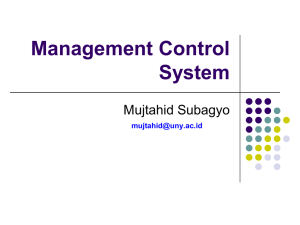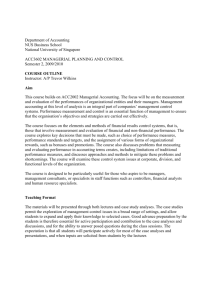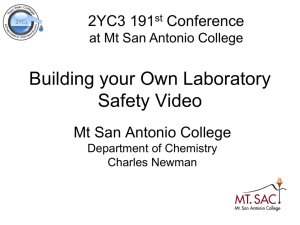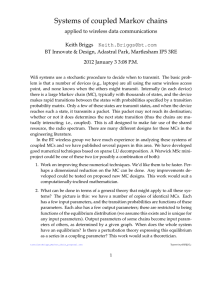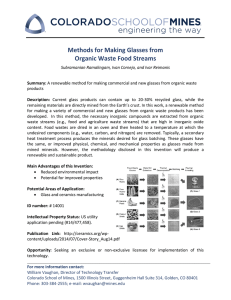Glass Formation in a Lattice Model for Living Polymers
advertisement
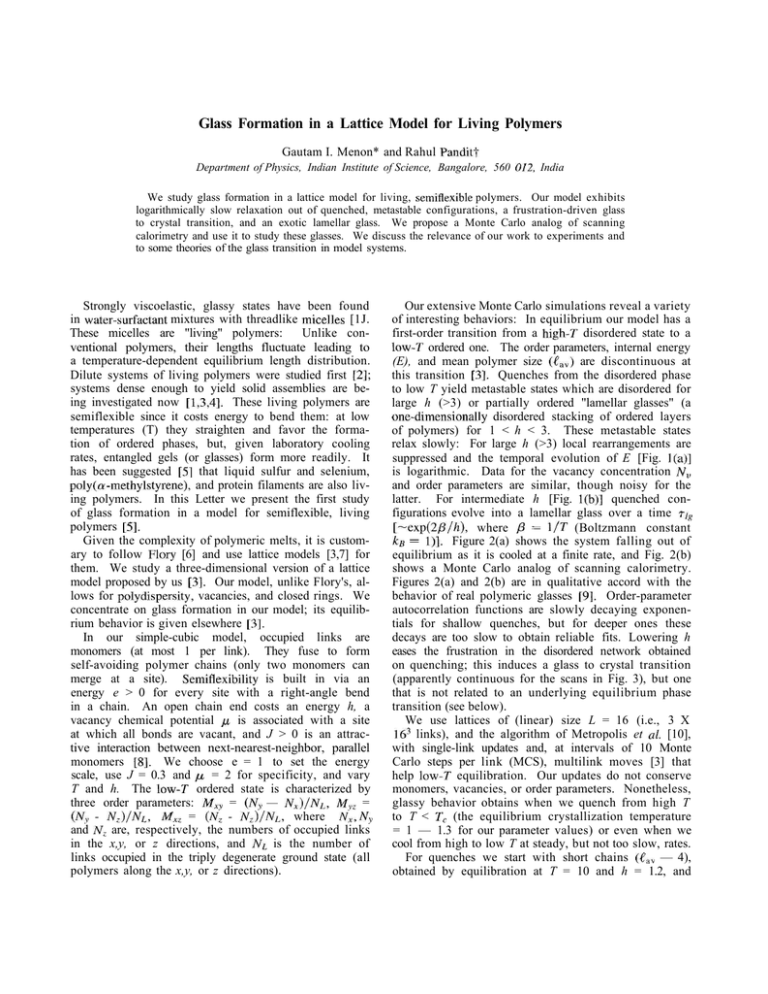
Glass Formation in a Lattice Model for Living Polymers
Gautam I. Menon* and Rahul Panditt
Department of Physics, Indian Institute of Science, Bangalore, 560 012, India
We study glass formation in a lattice model for living, semiflexible polymers. Our model exhibits
logarithmically slow relaxation out of quenched, metastable configurations, a frustration-driven glass
to crystal transition, and an exotic lamellar glass. We propose a Monte Carlo analog of scanning
calorimetry and use it to study these glasses. We discuss the relevance of our work to experiments and
to some theories of the glass transition in model systems.
Strongly viscoelastic, glassy states have been found
in water-surfactant mixtures with threadlike micelles [1J.
These micelles are "living" polymers:
Unlike conventional polymers, their lengths fluctuate leading to
a temperature-dependent equilibrium length distribution.
Dilute systems of living polymers were studied first [2];
systems dense enough to yield solid assemblies are being investigated now [1,3,4]. These living polymers are
semiflexible since it costs energy to bend them: at low
temperatures (T) they straighten and favor the formation of ordered phases, but, given laboratory cooling
rates, entangled gels (or glasses) form more readily. It
has been suggested [51 that liquid sulfur and selenium,
poly(a-methylstyrene), and protein filaments are also living polymers. In this Letter we present the first study
of glass formation in a model for semiflexible, living
polymers [5].
Given the complexity of polymeric melts, it is customary to follow Flory [6] and use lattice models [3,7] for
them. We study a three-dimensional version of a lattice
model proposed by us [3]. Our model, unlike Flory's, allows for polydispersity, vacancies, and closed rings. We
concentrate on glass formation in our model; its equilibrium behavior is given elsewhere [3].
In our simple-cubic model, occupied links are
monomers (at most 1 per link). They fuse to form
self-avoiding polymer chains (only two monomers can
merge at a site). Semiflexibility is built in via an
energy e > 0 for every site with a right-angle bend
in a chain. An open chain end costs an energy h, a
vacancy chemical potential /u. is associated with a site
at which all bonds are vacant, and J > 0 is an attractive interaction between next-nearest-neighbor, parallel
monomers [8]. We choose e = 1 to set the energy
scale, use J = 0.3 and jj, = 2 for specificity, and vary
T and h. The low-T ordered state is characterized by
three order parameters: Mxy = (Ny — NX)/NL, Myz =
(Ny - NZ)/NL, MK = (Nz - NZ)/NL, where Nx,Ny
and Nz are, respectively, the numbers of occupied links
in the x,y, or z directions, and NI is the number of
links occupied in the triply degenerate ground state (all
polymers along the x,y, or z directions).
Our extensive Monte Carlo simulations reveal a variety
of interesting behaviors: In equilibrium our model has a
first-order transition from a high-T disordered state to a
low-T ordered one. The order parameters, internal energy
(E), and mean polymer size (€ av ) are discontinuous at
this transition [3]. Quenches from the disordered phase
to low T yield metastable states which are disordered for
large h (>3) or partially ordered "lamellar glasses" (a
one-dimensionally disordered stacking of ordered layers
of polymers) for 1 < h < 3. These metastable states
relax slowly: For large h (>3) local rearrangements are
suppressed and the temporal evolution of E [Fig. l(a)]
is logarithmic. Data for the vacancy concentration Nv
and order parameters are similar, though noisy for the
latter. For intermediate h [Fig. l(b)] quenched configurations evolve into a lamellar glass over a time TIS
[~exp(2/3//i), where f) = l/T (Boltzmann constant
£B = 1)]- Figure 2(a) shows the system falling out of
equilibrium as it is cooled at a finite rate, and Fig. 2(b)
shows a Monte Carlo analog of scanning calorimetry.
Figures 2(a) and 2(b) are in qualitative accord with the
behavior of real polymeric glasses [9]. Order-parameter
autocorrelation functions are slowly decaying exponentials for shallow quenches, but for deeper ones these
decays are too slow to obtain reliable fits. Lowering h
eases the frustration in the disordered network obtained
on quenching; this induces a glass to crystal transition
(apparently continuous for the scans in Fig. 3), but one
that is not related to an underlying equilibrium phase
transition (see below).
We use lattices of (linear) size L = 16 (i.e., 3 X
163 links), and the algorithm of Metropolis et al. [10],
with single-link updates and, at intervals of 10 Monte
Carlo steps per link (MCS), multilink moves [3] that
help low-71 equilibration. Our updates do not conserve
monomers, vacancies, or order parameters. Nonetheless,
glassy behavior obtains when we quench from high T
to T < Tc (the equilibrium crystallization temperature
= 1 — 1.3 for our parameter values) or even when we
cool from high to low T at steady, but not too slow, rates.
For quenches we start with short chains (€ av — 4),
obtained by equilibration at T = 10 and h = 1.2, and
(a)
h = 3.5,H=2,J=0.3
0.3
0.2
0.1
(a)
100+100 MCS
h=3.5,n=2,J=0.3
0.2
0.1
LU
LU
0
-0.1
-0.2
104
t (MCS)
10J
*• ' h=1.5,u,=2,J=0.3
T0 = 0.53
Cooling scan
Equilibrium
0.6
0.2
TQ - 0.63
0.8
1
I
500+200 MCS
1000+200 MCS
0.73
-0.05
0.1
1.2
1.4
(b)
/*'
LU
-0.1
-0.1
-0.15
-0.2
J
10
4
10
t (MCS)
FIG. 1. The energy E vs time / after a quench to T = TQ
for L = 16 showing (a) a logarithmic decay at large h and (b)
a somewhat faster decay at intermediate h. In (b) the system
eventually becomes a lamellar glass and E does not evolve over
our t range.
reduce T in one step to TQ < Tc. We compute E,NV,
etc., at a time t (in MCS) by averaging over 20 measurements, centered at t; each measurement is made every 10
MCS; we follow the time evolution for (3 - 6) X 105
MCS. Different initial configurations, including ones at
T = x, yield qualitatively similar results.
For small h (<1.5) quenches yield configurations that
evolve over 100-1000 MCS to the equilibrium crystal.
For intermediate values (1.5 < h < 3) the quenched
system evolves, in a time T/g, to a lamellar glass; order
parameters saturate to values between 0 (the high-7'
value) and 1 (the perfect crystal). Our data [Fig. 1 (b)]
are consistent with r\B ~ exp(2/3/*). Once formed, these
lamellar glasses do not evolve substantially even if
annealed for — 106 MCS, since a large number [at least
O(L2)] of local updates are required to align all planes.
At large h (>3), quenches yield complex, disordered
structures, which evolve slowly: Order parameters, E,
and Nv all vary logarithmically, especially for the deepest
quench [103 < t < 2 X 105 MCS in Fig. l(a)]. Such
logarithmic behavior often occurs in disordered systems.
However, in our model disorder does not arise because
-0.2
0.6
h=3.5,u.=2,J=0.3
0.8
1.4
FIG. 2. (a) The evolution of E with temperature T on steady
cooling (circles) to T < Tc at large h [= 3.5 here with
annealing and recording times (see text) ta = tr = 100] and
in equilibrium (triangles), (b) E vs T for our Monte Carlo
scanning calorimetry (see text) after a quench to TQ = 0.63.
We use two heating rates indicated by circles (ta = 500
and tr = 200) and triangles (ta = 1000 and tr = 200). At
the slower heating rate (triangles), the glass transforms more
effectively into a crystal (the flat minimum in the curve with
E - -0.17; for the ordered crystal E - -0.2) before it melts
eventually into the disordered high-'T phase.
of random couplings but is generated dynamically by the
quench, as in conventional glasses. The slow decrease of
Nv is reminiscent of the volume contraction seen during
the aging of polymeric glasses [11], normally ascribed to
decreasing "free volume" as in some theories [12].
A glass also forms if we cool the system at a finite rate
(not slow enough for equilibration) through Tc: We begin
with equilibrated configurations at T = 1.5 and lower T
in steps of 0.005. The time / (MCS) that we spend at
a particular T (or h in Fig. 3) in our scans is divided
into an annealing time ta (— 200—1000 MCS), during
which we do not record data, and a recording time tr
(— 100 — 200 MCS), in which we collect data for averages
every 10 MCS. Cooling or heating rates for Figs. 2 and 3
follow from t, given as ta + tr MCS. The h dependence
of the morphologies of these glasses is similar to those
obtained in our quenches: For h < 1.5 our system can be
supercooled just a little before it crystallizes. For 1.5 <
0.12
• 200 + 200 MCS
^V
j/*>
• - 600 + 200 MCS
.J*^ fT
° 1 000 + 200 MCS /
/
0.14
s^*f j^
"
«*?
/:'
/ :
LJJ
0.16
*
0.18
»
1.6
.*
f
/
c?
o
1.8
<f*
TQ=0.63
u=2,J=0.3
2.2
FIG. 3. E versus the frustration parameter h at three scanning
rates (see text) with tr = 200 but ta = 200 (filled circles), 600
(triangles), and 1000 (open circles). As h is lowered from
3.5, its value when we quench to TQ = 0.63, an apparently
continuous glass-crystal transition occurs and E flattens out.
The value of h at the transition depends on the scanning rate.
h < 3 the system falls out of equilibrium (E drops with
T but not as sharply as in equilibrium [Fig. 2(a)]) to form
lamellar glasses; for h > 3 it freezes into a completely
disordered configuration, but with slightly larger ordered
patches than for instantaneous quenches.
We also study our model via a Monte Carlo analog
of scanning calorimetry, which yields successive glasscrystal and crystal-liquid transitions by a steady heating
of our glasses. As far as we know this is the first
time scanning calorimetry has been adapted to Monte
Carlo studies of glassy states. We quench the system
from T = 10 (see above) to Tc/2, anneal it for 6 X
105 MCS, and then increase T at 10~6 per MCS. We
concentrate on large h (>3); for small and intermediate
h we get crystals or lamellar glasses which melt directly
to the disordered phase. Our data for large h show
that heating transforms the glass into a crystal, which,
on further heating, melts into the disordered phase. E
drops sharply at the glass-crystal transition [Fig. 2(b)]; the
range of T over which the crystal appears increases with
decreasing heating rate. For sufficiently slow heating rates
[triangles in Fig. 2(b)], both these transitions appear to be
discontinuous. From Fig. 2(b) one can obtain d(E}/dT
(numerically); this yields the analog of an experimental
differential-scanning-calorimetry plot [9] and shows both
an exotherm (because of relaxation out of a high fictivetemperature state formed by the quench) and a sharp
overshoot, as is often seen in rapidly cooled, annealed,
and slowly reheated glasses [9,13]. The crystal-liquid
transition resembles equilibrium melting. In some scans
more complicated transitions obtain: the glass transforms
to a crystal which reforms at a slightly higher temperature
into a glass. This glass then becomes a crystal which melts
to the disordered phase.
Glass formation occurs in our model because of local
frustration induced by self-avoidance (which restricts
updates involving the addition of monomers to the melt)
coupled with a large barrier for the removal of a link
(whose scale is set by h, for large h). Thus h plays
a crucial role in slowing down the kinetics; but, for
large h, it plays a relatively minor role in determining
the equilibrium Tc [3]. Hence we interpret h as a
"frustration parameter" (like size ratios in a LennardJones mixture [14]) and study E, etc., as h is changed:
We prepare glassy configurations by annealing quenched
configurations for 6 X 105 MCS at Tc/2, and large h
(h = 3.5 in Fig. 3). We then decrease h in steps of 5 X
1(F3; annealing and recording times ta and tr are as in
Fig. 2. On decreasing h we get an apparently continuous
transition: E decreases monotonically and smoothly to a
value characteristic of the crystal. Figure 4, a smoothened
numerical derivative of one of the curves (triangles), is
similar to a susceptibility at a continuous, equilibrium
transition. Such transitions have been invoked in some
scenarios for the glass transition [15]. However, in
our model there is no equilibrium transition underlying
this frustration-driven transition. Firstly, the transition is
not reversible: no crystal to glass transition occurs on
increasing h. Secondly, our results depend on the rate
at which h is changed; slower scans than those of Fig. 3
would make the transition disappear, for the glass would
become a crystal at higher and higher values of h.
We have also studied temporal autocorrelations in the
glasses obtained by annealing quenched configurations at
different T < Tc. Autocorrelation functions like A^x\t) =
T?1.i[{px(i,to = fypx(i,to = 0> ~ <P*(«,*o> 2 ] and its y
and z analogs can be fit to exponentials with large autocorrelation times, which increase as h is increased or as
T is decreased. For h = 3.5 and T = 0.7, these autocorrelation times are = 500 MCS. For lower T or higher
h our data indicate decays too slow and noisy to yield
0.6
TQ=0.63
|l=2,J=0.3
0.4
s
73
0.2
1.5 1.55 1.6 1.65 1.7 1.75 1.8
h
FIG. 4. A smoothened numerical derivative dE/dh vs h for
the data of Fig. 3 for ta = 600 shows a peak at the apparently
continuous glass-crystal transition.
meaningful fits, leaving open the possibility of nonexponential large-? behaviors.
Lattice models for glass formation in polymer melts go
back to Gibbs and DiMarzio [16], who extrapolated Flory's
mean-field expression for the configurational entropy below its equilibrium transition temperature. They found a
continuous transition to the glass; however, their work relies on the Flory approximation (inadequate in many cases,
e.g., d = 2), and the (implicit) assumption that the lowT extrapolation is meaningful. As mentioned above, our
simulations show no underlying equilibrium glass transition. In recent MC simulations of glasses in a twodimensional lattice model for a conventional polymeric
melt, Ray and Binder [17] find glassy states with nonexponential decays of autocorrelation functions at low T'.
However, their model has an equilibrium transition only
at T = 0, so it cannot yield scanning-calorimetric plots
like ours, nor does it have a simple frustration parameter
that can be varied. But since their simulation conserves
the number of monomers, they can obtain diffusion constants which we cannot. Our model and the spin-facilitated
model of Fredericksen and Andersen [18] have interesting connections, for, in both, relaxation at low temperatures occurs via highly cooperative moves. However, our
model has the advantage that it yields both equilibrium
freezing and glass formation. Of course, to model glass
formation in real polymeric melts, we should, ideally, use
a continuum description and enforce the relevant conservation laws. Conservation laws will, in general, lead to
longer equilibration times and slower relaxation than in
our model, in which no quantity is conserved.
Our study of a simple model shows how an interplay
of semiflexibility, self-avoidance, and the energy cost for
breaking chains leads to the vitrification of a melt of
living polymers. Furthermore, our model is a good testing
ground for theories of the glass transition, since frustration
can be tuned easily. In a more general context, our model
can be thought of as a spin model (or lattice gas) without
quenched disorder which exhibits a transition to a glassy
state at low temperatures [19]. It would be interesting to
see whether lamellar glasses form in real polymeric melts
or are merely an artifact of our lattice model. We hope
our work stimulates experimental studies of glasses and
gels in melts of living polymers.
We thank J. Banavar, M. Barma, C. Dasgupta, S. Ramaswamy, T. V. Ramakrishnan, M. Rao, and R. Rao for
discussions, CSIR and DST (India) for support, and SERC
(IISc, Bangalore) for computational facilities.
*Current address: Tata Institute of Fundamental Research,
Homi Bhabha Road, Bombay 400 005, India.
fAlso at Jawaharlal Nehru Centre for Advanced Scientific
Research, Bangalore, India.
[1] B.K. Mishra et al., Langmuir 9, 894 (1993); P. S. Goyal
et al, Physica (Amsterdam) 156-157B, 471 (1989).
[2] G. Porte, J. Marignan, P. Bassereau, and R. May, J. Phys.
49, 511 (1988); M.S. Turner and M.E. Gates, J. Phys.
(Paris) 51, 307 (1990).
[3] G. I. Menon, R. Pandit, and M. Barma, Europhys. Lett. 24,
253 (1993); G.I. Menon and R. Pandit (to be published).
[4] R. Granek and M.E. Gates, J. Chem. Phys. 96, 4758
(1992); P. van der School and M.E. Gates (to be
published).
[5] A. Milchev and D. P. Landau (to be published); S.J.
Kennedy and J.C. Wheeler, J. Phys. Chem. 78, 953
(1984); G. Faivre and J. L. Gardissat, Macromolecules
19, 1988 (1986); K.M. Zheng and S. C. Greer, Macromolecules 25, 6128 (1992); F. Oozawa and S. Asakura,
Thermodynamics in the Polymerization of Proteins (Academic Press, New York, 1975).
[6] P.J. Flory, Proc. R. Soc. London A 234, 60 (1956); 234,
73 (1956).
[7] P.O. Gujrati and M. Goldstein, J. Chem. Phys. 74,
2596 (1981); A. Baumgartner, J. Phys. A 17, L971-L974
(1984); A. Baumgartner and D.Y. Yoon, J. Chem. Phys.
79, 521 (1983); H. Saleur, J. Phys. A 19, 2409 (1986);
G.F. Tuthill and M.V. Jaric, Phys. Rev. B 31, 2981
(1985); A. Milchev, Polymer 34, 362 (1993).
[8] J > 0 lifts the ground-state degeneracy (= oo) at J — 0
[3].
[9] S.Z.D. Cheng, Z. Q. Wu, and B. Wunderlich, Macromolecules 20, 2802 (1987).
[10] See, e.g., Monte Carlo Methods in Statistical Physics,
edited by K. Binder (Springer-Verlag, Berlin, 1979).
[11] H.-H. Song and R.-J. Roe, Macromolecules 20, 2723
(1987).
[12] M.H. Cohen and G.S. Grest, Phys. Rev. B 20, 1077
(1979).
[13] I.M. Hodge, J. Non-Cryst. Solids 169, 211 (1994).
[14] C. Dasgupta, A. V. Indrani, S. Ramaswamy, and M. K.
Phani, Europhys. Lett. 15, 307 (1991).
[15] J.P. Sethna, Europhys. Lett. 6, 529 (1988).
[16] J.H. Gibbs and E.A. DiMarzio, J. Chem. Phys. 28, 373
(1958); 28, 807 (1958).
[17] P. Ray and K. Binder (to be published); J. Non-Cryst.
Solids 172-174 (1994).
[18] G.H. Frederickson and H.C. Andersen, Phys. Rev. Lett.
53, 1244 (1984).
[19] J. P. Bouchard and M. Mezard, J. Phys. I (France) 4, 1109
(1994).

